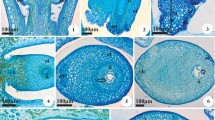Abstract
The mature seeds ofHampea nutricia are glabrous, ovoid, arillate and dark tan in colour. Longitudinal streaks on the seed surface correspond to the underlying integumentary vascular strands. Testa and tegmen are derived from the outer and inner integuments, respectively. The outer epidermis of the tegmen forms a palisade-like macrosclereid layer, the inner epidermis a fringe layer. The endosperm is single-layered and also fills the space between the two cotyledons. The embryo is nearly straight, gland-dotted; it has asymmetrical and folded cotyledons, and gossypol ducts. Systematic position ofHampea is discussed and its placement inMalvaceae is supported.
Similar content being viewed by others
References
Baker, H. G., Baker, I., 1968: The chromosome numbers inBombacaceae. — Bot. Gaz.129, 294–296.
Bentham, G., Hooker, J. D., 1867: Genera Plantarum, I. — London: Reeve and Company.
Bhatnagar, S. P., Chandra, S., 1978: Reproductive biology ofAbelmoschus esculentus V. Post pollination development of seed-coat, perisperm, micropyle, raphe and funiculus. — Acta bot. Indica6, 36–42.
Chandra, S., Bhatnagar, S. P., 1975: Reproductive biology ofAbelmoschus esculentus VI. Seed development. — Pl. Syst. Evol.123, 255–262.
Chauhan, M. P. S., 1980: Development and Structure of Seeds in someMalvaceae. — Ph.D. Thesis, Kanpur University, Kanpur.
Corner, E. J. H., 1976: The Seeds of Dicotyledons. Vols. I, II. — Cambridge: Cambridge University Press.
Edlin, H. L., 1935: A critical revision of certain taxonomic groups of theMalvales. — New Phytol.34, 1–20, 122–143.
Engler, A., Prantl, K., 1895: Die Natürlichen Pflanzenfamilien. Vol.3/6, 30–53. — Leipzig: Wilhelm Engelmann.
Erdtman, G., 1952: Pollen Morphology and Plant Taxonomy. — Waltham, Mass., U.S.A.: Chronica Botanica Co.
Fryxell,,P. A., 1968: A redefinition of the tribeGossypieae. — Bot. Gaz.129, 296–308.
—, 1969: The genusHampea (Malvaceae). — Brittonia21, 359–396.
—, 1967:Hampea Schlecht. Possible primary host of the cotton boll weevil. — Science155, 1568–1569.
Gaoli, H. P., 1977: Embryology ofMalvastrum coromandelianum Garcke. In:Dnyansagar, V. R., Deshpande, P. K., Pandhye, M. D., (Eds.): Recent Trends and Contacts between Cytogenetics, Embryology and Morphology, pp. 371–381. — New Delhi: Today & Tomorrow's Printers and Publishers.
Hutchinson, J., 1967: The Genera of Flowering Plants. Dicotyledones. Vol. II. — Oxford: Clarendon Press.
Joshi, P. C., Wadhwani, A. M., Johri, B. M., 1967: Morphological and embryological studies ofGossypium. — Proc. Natl. Inst. Sci. India33B, 37–93.
Johansen, D. A., 1940: Plant Microtechnique. — New York: McGraw Hill.
Lukefahr, M. J., Fryxell, P. A., 1969: The role ofHampea sp. in the migration of the cotton leaf worm to the United States. — J. Econ. Entomol.62, 263–264.
Mohana Rao, P. R., 1978: Seed and fruit anatomical studies inMalvaceae. 1.Thespesia populnea. — Phytomorphology28, 239–244.
Raven, P. H., 1975: The bases of angiosperm phylogeny: cytology. — Ann. Mo. Bot. Gdn.62, 724–764.
Reeves, R. G., 1936a: Comparative anatomy of seeds of cotton and other malvaceous plants. I.Malveae andUreneae. — Am. J. Bot.23, 291–296.
- 1936b: Comparative anatomy of seeds of cotton and other malvaceous plants. II.Hibisceae. — Ibid.23, 394-405.
—, 1936c: The origin of fringe tissue of cotton seed. — Bot. Gaz.97, 179–184.
Singh, Bahadur, 1967: The structure and development ofAbelmoschus moschatus seeds. — Phytomorphology17, 282–290.
Tsukada, M., 1964: Pollen morphology and identification. III. Modern and fossil tropical pollen with emphasis onBombacaceae. — Pollen et Spores6, 393–462.
Venkata Rao, C., 1955: Embryological studies inMalvaceae. 2. Fertilization and seed development. — Proc. Natl. Inst. Sci. India21 B, 53–67.
Wilson, F. D., 1968: In “IOPB Chromosome number reports”. —Malvaceae — Taxon17, 577.
Author information
Authors and Affiliations
Rights and permissions
About this article
Cite this article
Singh, R.P., Chauhan, M.P.S. Seed structure and systematic position ofHampea nutricia (Malvaceae). Pl Syst Evol 147, 55–61 (1984). https://doi.org/10.1007/BF00984579
Received:
Issue Date:
DOI: https://doi.org/10.1007/BF00984579




